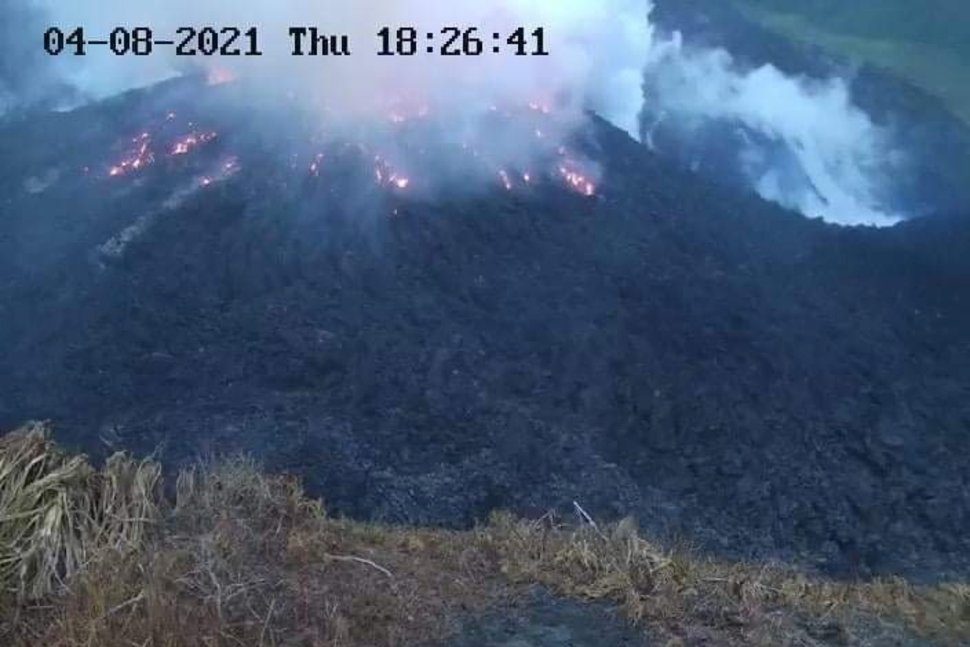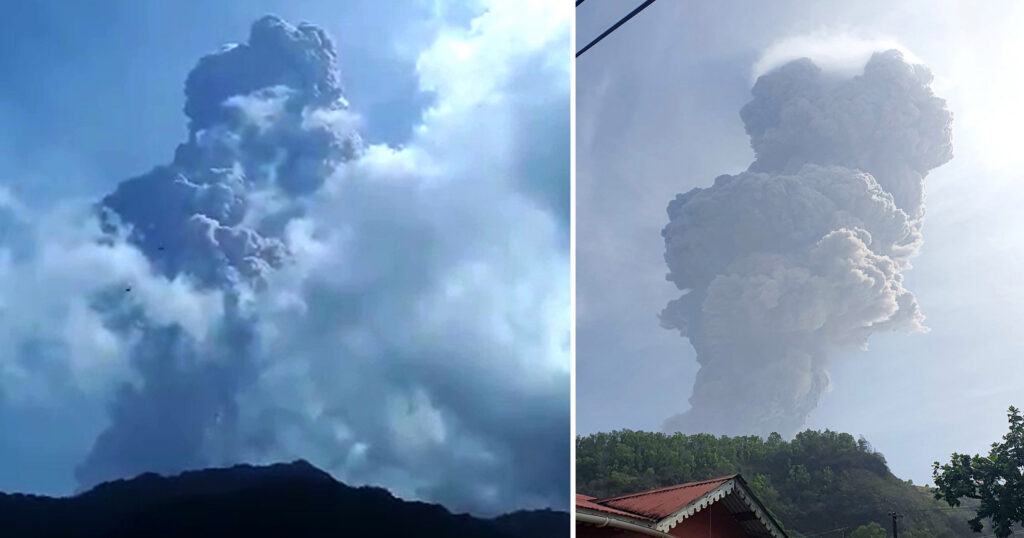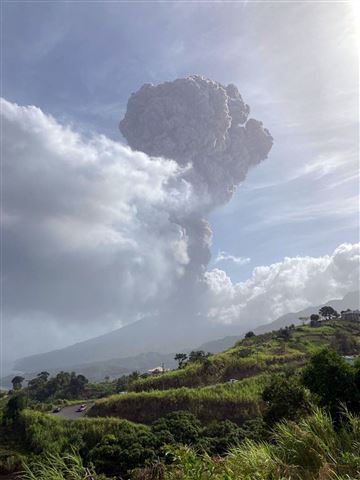KINGSTOWN — After months of warnings it would, the La Soufrière volcano on St. Vincent finally erupted early this morning, sending nearly a four-mile high plume of ash into the air hours after residents were ordered to evacuate the area, officials said.
Photos and videos captured clouds of smoke coming out of the volcano about 8:40 a.m. as a thin layer of gray ash appeared to cover the surrounding area.
Emergency management officials said the ash column was about 20,000 feet (6 kilometers) high and that the ash was headed east into the Atlantic Ocean.

However, heavy ashfall also was reported in communities around the volcano, said Erouscilla Joseph, director of the University of the West Indies Seismic Research Center.
“More explosions could occur,” she said, adding that it was impossible to predict whether any potential upcoming explosions would be bigger or smaller than the first one.
There were no immediate reports of casualties or injuries.
The volcano last erupted in 1979, and a previous eruption in 1902 killed some 1,600 people. La Soufriere also erupted in 1718, 1812 and 1814, according to the Seismic Research Center.
The latest one followed mandatory evacuation orders issued Thursday for people who live near the volcano. Officials planned to place them aboard cruise ships, send them to nearby islands or take them to shelters elsewhere in St. Vincent that are outside the danger zone.
Roughly 16,000 people live in the red zone and will need to be evacuated, Joseph said.
“Evacuation of people in the red and orange zones to safe areas continues in earnest,” St. Vincent’s National Emergency Management Organization said in a tweet. “Heavy ash fall has halted the process somewhat since visibility is extremely poor. NEMO continues to respond to the many challenges of the process #lasoufrierevolcanoeruption2021“
The pandemic could also hamper evacuation efforts.
Prime Minister Ralph Gonsalves said in a press conference that people have to be vaccinated if they go aboard a cruise ship or are granted temporary refuge in another island. He said two Royal Caribbean cruise ships are expected to arrive by Friday and a third one in the coming days, as well as two Carnival cruise ships by Friday. Islands that have said they would accept evacuees include St. Lucia, Grenada, Barbados and Antigua.
“Not everything is going to go perfect, but if we all cooperate … we will come through this stronger than ever,” Gonsalves said.
He noted that he was talking to Caribbean governments to accept people’s ID cards if they don’t have a passport.
“This is an emergency situation, and everybody understands that,” he said.
Gonsalves added that he highly recommends those who opt to go to a shelter in St. Vincent and the Grenadines, an island chain of more than 100,000 people, be vaccinated.
Emergency management teams have been going out to communities in the red zone and providing transportation to safer locations, including prearranged shelters, according to Joseph.
“They know who doesn’t have transportation because all of this has been canvassed before,” she said, adding that those who board the cruise ship would not be taken elsewhere but would remain there for an unspecified period of time.
By late Thursday evening, shelters were filling up as a string of car lights making their way to safer ground twinkled through the darkened mountains.
John Renton, a school principal who was in charge of one shelter, said in a phone interview that they had plenty of masks and other personal protective equipment but needed more cots. While talking, he was interrupted by a phone call from a government official asking about the state of things. “We’re over capacity,” he responded, noting that the shelter could hold 75 people and was already filled up.
Government officials tweeted that the dome of the volcano located on the island’s northern region could be seen glowing by nightfall. The alert issued Wednesday follows days of seismic activity around La Soufriere.
Gonsalves urged people to remain calm and orderly.
“I don’t want you panicked,” he said. “That is the worst thing to do.”
Scientists alerted the government about a possible eruption after noting a type of seismic activity at 3 a.m. on Thursday that indicated “magma was on the move close to the surface,” Joseph said.
“Things are escalating pretty quickly,” she said of the volcanic activity, adding that it was impossible to provide an exact forecast of what might happen in the next hours or days.
A team from the seismic center arrived in St. Vincent in late December after the volcano had an effusive eruption. They have been analyzing the formation of a new volcanic dome, changes to its crater lake, seismic activity and gas emissions, among other things.
Those living near the volcano had started evacuating on Thursday via ships and by road.
“People are still being evacuated from the red zone, it started yesterday evening and into last night,” said Lavern King, 28, a volunteer at shelters in the capital Kingstown and elsewhere. “The place in general is in a frenzy.”
St. Vincent and the Grenadines, which has a population of just over 100,000, has not experienced volcanic activity since 1979. An eruption by La Soufriere in 1902 killed more than 1,000 people. The name means “sulfur outlet” in French.
Local media have in recent days also reported increased activity from Mount Pelee on the island of Martinique, which lies to the north of St. Vincent beyond St. Lucia.
The eastern Caribbean is home to other active volcanoes. Seventeen of the region’s 19 live volcanoes are located on 11 islands, with the remaining two underwater near the island of Grenada, including one called Kick ’Em Jenny that has been active in recent years.
Reporting by Wilson Wong of NBC News in St. Vincent and the Grenadines, Sarah Marsh in Havana and Kate Chappell in Kingston; Writing by Frank Jack Daniel; Editing by Howard Goller
Our Standards: The Thomson Reuters Trust Principles.




